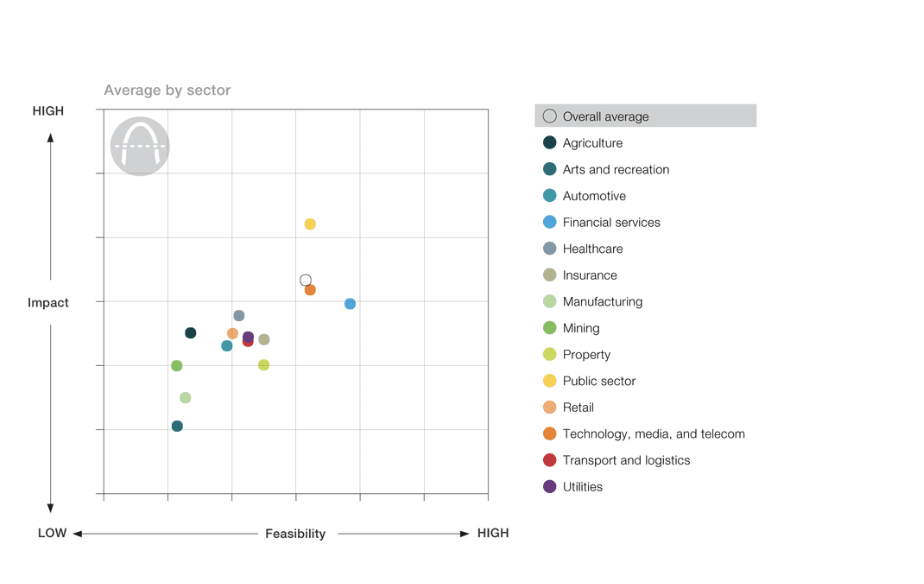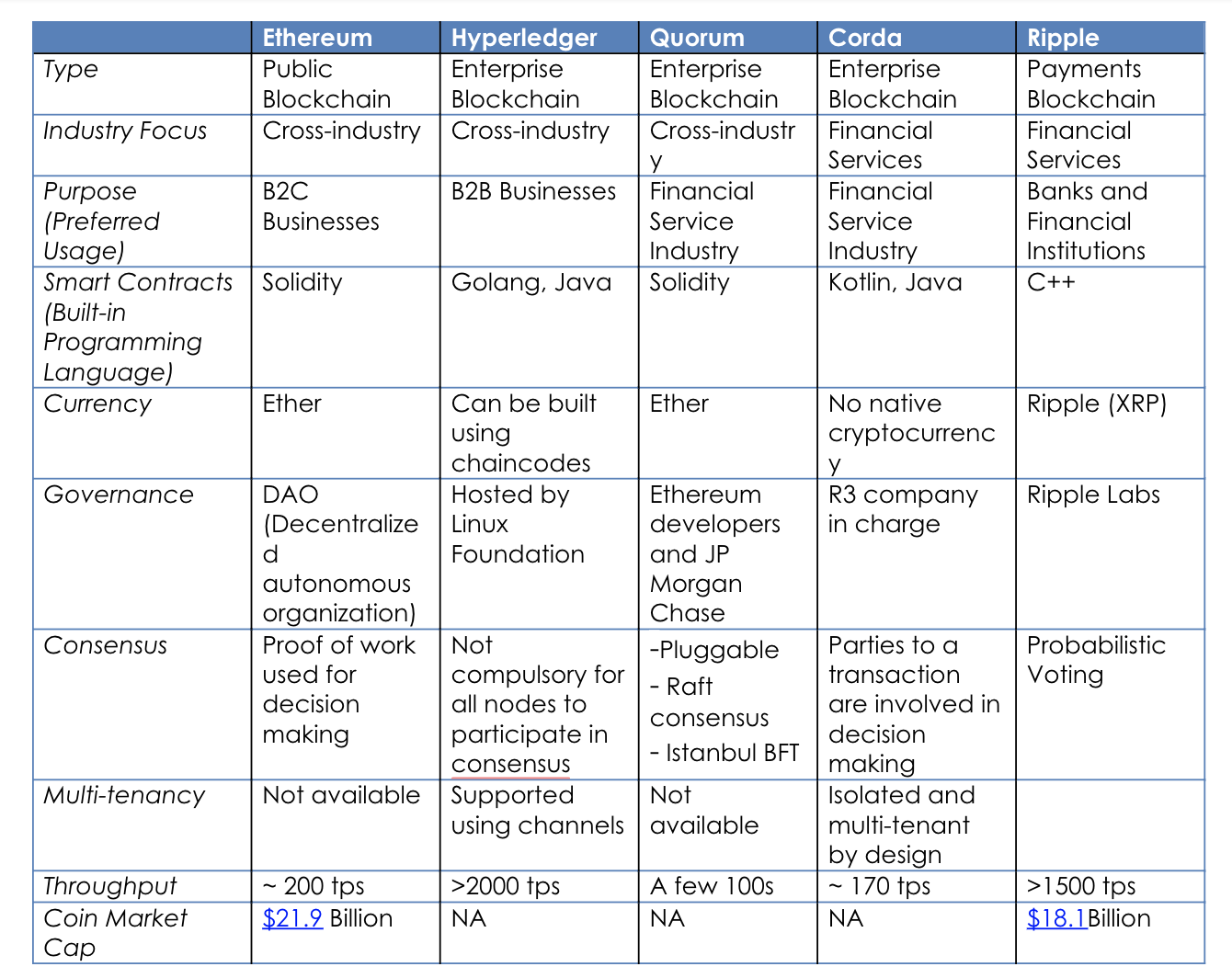The 5 best blockchain platforms for enterprises and what makes them a good fit.

Oumnia El Khazzani
over 5 years ago

Blockchain technology has the potential to disrupt and fundamentally transform the financial world.
With the advent of Bitcoin as an alternative currency and ICOs raking in billions of dollars, the blockchain world has been on hyperactive mode for the last 4-5 years.
But more than cryptocurrencies, enterprise adoption of blockchain has generated strong interest from major players. Though tech businesses should have a more natural affinity for blockchain technology, it is traditional financial services businesses that have taken the lead in incorporating blockchain in their business operations.
An article in Euromoney puts it straightforwardly.

JP Morgan’s Quorum is one of the biggest examples of Wall Street’s Blockchain applications.
Why Enterprise Blockchain?
The key tenant of public blockchains is decentralization and transparency. But an enterprise needs a central authority to maintain privacy and control. The permissioning process at each level of the transaction cycle ensures the security of data and protection of intellectual property of businesses. It has low latency rates and simpler protocols as compared to public blockchains.
Moreover, massive electricity consumed by the bitcoin systems (public blockchain) due to the ‘proof of work’ mechanism for the processing of transactions is off-putting both cost and speed.
A private blockchain allows organizations to be nimble enough to pivot the blockchain as per its requirements as compared to the drawn-out process of generating consensus in a public blockchain system.
Below is a list of factors that have contributed to the increased demand for Enterprise Blockchain:
- Reduced administrative cost and fast processing of transactions (use of smart contracts eliminates the extra efforts in clearing, settlement, etc.)
- Reduced chances of fraud, human error or manipulation
- Enhanced yet controlled transparency
- Elimination of extra charges of offline reconciliations
- Secured settlement of cross-company transactions
- Real-time data access
- Authorized access
- Reduction of redundancy in the organizations
Market Share:
Distributed Ledger Technology has provided multiple benefits to organizations requiring high trust in the execution of their core transactions. Low-cost infrastructure development and maintenance has facilitated faster yet cost-effective processing. Not just financial services, industries like healthcare, energy, transportation, etc., are also investing in blockchain technology to integrate it into daily operations.
As a result of changing preferences, the enterprise blockchain market size is expected to reach $20.3 billion by 2025 up from its present size of $4.6 billion (2018).
Finance and manufacturing are expected to dominate others in the race to adopting enterprise blockchain. McKinsey’s Analysis of Blockchain Opportunities by Industrial Sector:

Elements of a successful platform:
Requirements of businesses wishing to use blockchain are different from that of consumer applications. Some of the features that an ideal enterprise blockchain needs in order to effectively serve the end users are listed as follows:
Confidentiality:
Although blockchain is all about transparency, enterprise transactions usually deal with extremely sensitive data. Universal access (even throughout the organization) could cause huge losses to the parties concerned. Thus, strong privacy features are one of the elements that a blockchain platform must have as its inherent feature along with adherence to the applicable regulatory and legal requirements.
Considering a use case of Hyperledger Fabric; it helps protect enterprise data through a three-level data flow structure:
- Separate Ledger: Grouping a set of information under separate channels to give access to authorized users only.
- Confidential Transactions: Introducing additional privacy in terms of keeping data confidential between the parties concerned, not allowing access to the third party.
- Zero-knowledge validation: To prove the title of data by proving certain aspects without actually revealing the data.
Transparency:
Lack of transparency across each level in the supply chain can interrupt the smooth flow of information within an organization. Most of the large organizations also hesitate to share information regarding the provenance of their goods, as they fear of losing their position in the market against their competitors. For example, pricing mechanism and contractual details are an internal affair to any business, which if accidentally shared could benefit peers as they can modify their strategies to capture the current market share of the organization. An efficient blockchain system shall equip such organizations with a trusted network, helping them maintain transparency while not disclosing the entity’s core confidential information. A high level of privacy shall be ensured as transaction details are to be shared only among parties connected to each transaction with access based on permission.
Operational Cost Reduction: Reduced Manual Intervention: Elimination of middlemen and reduced manual intervention due to automation of processes will save enterprises from unnecessary cost and efforts. Smart Contracts which allow for auto-execution are a primary business use case. Audit Trail: Integrating technology solutions in the record-keeping system will reduce the cost of an audit, thereby making it easy to track the control over any asset and supply chain mechanism.
Cost Sharing:
Data can be easily exchanged between organizations through the use of DLT (Distributed Ledger Technology), without having to incur an extra cost of maintaining the information database on third party software which will also save organizations from cybersecurity issues.
A predictable cost is always considered as a better measure of performance instead of having so-called low-cost alternatives, which may not provide a reasonable assurance of stability in the future.
Thus, enterprise blockchain system must run on platforms having constant fees, thereby improving “operational predictability” of the overall blockchain system.
Transaction Cost Reduction:
Blockchain technology is changing the way financial transactions are being processed. Removal of third-party intervention and labor-intensive verification can reduce transaction costs to a great extent through the use of blockchain authentication. Enterprises could achieve efficiency in operations, control risks, and manage cost with the use of the latest blockchain enterprise mechanism. Putting the entire dataset on blockchain will also make it tamper-proof because of the use of digital signatures mechanism.
Major Blockchain Platforms:
Any organization deciding to implement blockchain may choose from the prominent frameworks available i.e. Ethereum, Hyperledger Fabric, Quorum, Corda, Ripple, etc. The final decision should be based upon the suitability of each to the organization.
Ethereum:
Ethereum (a public blockchain network) was developed by Vitalk Buterin (a 24- year- old Russian-Canadian). It is considered one of the efficiently developed platforms having smart contract features, flexibility, and multi-industry adaptability. Ethereum acts as a base component in building and developing most of the decentralized applications. ERC20 is the most popular token standard among cryptocurrencies. Stability, safety & security, corruption prevention, and zero downtime are some of the benefits offered by Ethereum over other applications.
How Ethereum is different:
- Ethereum offers greater transparency as compared to Hyperledger.
- The flexibility of the platform allows any developer to create applications using inbuilt programming language.
- Having ‘Ether’ as a built-in cryptocurrency provides a competitive edge to Ethereum applications over Hyperledger and Corda in use cases which requires cryptocurrency.
But the matter of fact is that Ethereum was built as a B2C application and its status as a public blockchain renders it difficult to co-opt in its current form for enterprise applications.
Hyperledger Fabric:
Hyperledger Fabric (launched in 2016) is a permissioned network that gives the authority to register each user through providing identity access and transaction authority that will define a range of the area within which each user can work and the areas where permissions would be required from other users.
The modular architecture of the platform places it among top choices for enterprise solutions.
Although it does not offer in-built currency feature, still the same can be created using chaincodes according to requirements. Hyperledger Fabric 1.1 is the latest release which claims to be production-ready for businesses.
Hyperledger is a series of projects by Linux Foundation and Fabric is IBM and Digital Asset’s contribution.
How Hyperledger Fabric is different:
- Confidentiality is achieved by encrypting the transactions which can be modified by only authorized persons. This feature solves the problem with Ethereum which offers transparency irrespective of privacy.
- Being built on the modular approach, it requires fewer levels of verification and thus optimizes the performance of the entire software.
- Data partitions on the blockchain allow enterprises to protect the data which is highly sensitive due to the implication of various laws or regulations by allowing access to the parties concerned.
Quorum:
Quorum is an Ethereum based enterprise-focused smart contract platform and permissioned network. The platform was created in the year 2016 through the introduction of EEA (Ethereum Enterprise Alliance). It supports both types of transactions i.e. public as well as private.
The platform is ideal to be used in applications demanding high speed and fast processing of private transactions. It is an evolving enterprise blockchain network that has made successful implementations in industries beyond financial service organizations.
How Quorum is different:
- Being a permissioned network, it offers complete data security and ease of accessibility.
- The speed of processing transactions is higher as compared to Ethereum which is the result of its simple consensus mechanism.
- Most of the updates in Ethereum can be easily integrated with Quorum as it is an extension of the Ethereum platform.
- With the backing of JP Morgan, Quorum is expected to take the lead in the financial services segment. There are further reports that JP Morgan is looking to spin off the project into a different company so that it can see wider adoption across the market.
Corda:
Corda (launched in 2015) functions on the concept of creating a global logical ledger where all users having a legitimate interest can communicate with each other and administer agreements and contracts.
Initially focused on financial organizations, Corda now aims to focus on other sectors including government, healthcare, trade finance, and supply chain initiatives.
How Corda is different:
- Only users having a legitimate interest can participate in the network which prevents unauthorized access to the database.
- Known for managing complex financial situations and ease of integration with legacy systems.
- Uses Notaries (centralized or distributed) in the network to address the privacy concerns, eliminating the need to perform expensive consensus algorithms.
Ripple:
Ripple, founded in 2012 by Chris Larsen and Jed McCaleb, acts as a global payment settlement mechanism providing services to the currency exchanges, banks, and digital asset exchanges.
It processes transactions through its digital currency named XRP that is among the most popular cryptocurrencies after Bitcoin and Ether. The portfolio is semi-permissioned blockchain and operates through a customer base of more than 100 enterprises with 75+ commercial establishments.
How Ripple is different:
- Low transaction fees, fast processing of transactions and transparency are some of the features of Ripple which distinguishes it from others.
- It provides an option to transact in multiple blockchain assets like BTC/LTC, non-native assets and currencies like USD, Yen, etc.
- A particular asset on the blockchain can be locked by using the feature of ‘Issuance’. The same can be transferred to other accounts without incurring a heavy cost as Ripple offers low fees services.
The table below is a good summary of the five platforms based on different parameters:
 Source: https://www.horsesforsources.com/top-5-blockchain-platforms_031618
Source: https://www.horsesforsources.com/top-5-blockchain-platforms_031618
Conclusion:
The use of advanced clouds to optimize power consumption along with usage of consensus algorithms to access the level of computational power required are some of the improvements in private networks over public blockchain networks.
Future of enterprise blockchain is evolving to a Blockchain 3.0 which allows for high scalability, sustainability, and governance as compared to existing blockchain networks in existence.
This empowers organizations to implement enterprise blockchain system using a platform of their choice i.e. Hyperledger, Corda, Ethereum, etc., and drive institutional adoption of the technology.
This analysis was brought to you by the Blockchain team at Swish. We support businesses integrate blockchain into their operations.
Do you have questions, comments? Interested to explore the potential of blockchain for your business? Let’s get in touch.